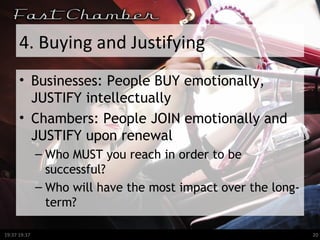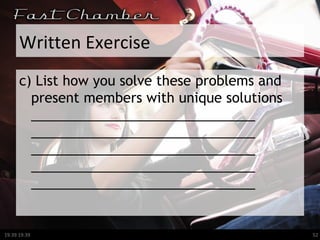Communicating Your Brand
- 1. COMMUNICATING YOUR BRAND Kyle J. Sexton | kyle@fastchamber.com FastChamber.com
- 2. The Marketing Umbrella Research Product Development Advertising Branding Publicity Communications Sales Customer Service Pricing Packaging Promotion
- 3. Why Are You Here? Your Chamber Wants: More new members To keep the ones you have Better referrals New ideas for your membership development strategy
- 4. Agenda Your brand affects your membership strategy Messaging: Words mean things Participation vs. Partnership Quantify the value of membership Creative advertising
- 5. Branding and Marketing “ Marketing is branding. The two concepts are so inextricably linked that it is impossible to separate them. Furthermore, since everything a company does can contribute to the brand-building process, marketing is not a function that can be considered in isolation.” 22 Immutable Laws of Branding, Al Ries and Laura Ries
- 6. What is a Brand? It’s more than a name Branding ‘pre-sells’ the product or service to the user Branding is simply a more efficient way to sell things A brand stands for something, a position in the mind It’s more than a logo A brand requires a visual vocabulary Consistent use of a “look and feel” A common “voice” and tone/style Standardized color palette, typefaces, visual style Consistent use of wording, tag lines, theme lines
- 7. Branding is Boring! It requires consistency Repetition of key phrases (radio burn) Redundant visual identity Target your audience Focus on presentation Creative limitations
- 8. Connecting to your customers “ Building brand awareness is not simply about throwing money at the moon. It’s about creating a consistent, emotional connection with your customers.” James Daly, Editor in Chief, Business 2.0
- 9. 2 Ways to choose your brand (1) Be who you want to be Decide how you want the public to perceive you Communicate and act in support of it Works for new companies, mergers, new markets New brands often rejected by consumers
- 10. 2 Ways to choose your brand Or (2) Be who you are Be who your audience/the public expects you to be Selectively reinforce what your existing customers feel and say about your product or service Run focus groups or surveys to find out why people buy initially, and why they return Collect testimonials to find common words, themes
- 11. 3 Steps to develop your brand 1. Who is your target audience? End user, Influencer, Buyer, or Referrer 2. Find their “hot buttons” 3. Tailor message to audience
- 12. 1. Who is your target audience? Do you know everyone you’re selling to? Who buys? Who influences? Who refers? Who uses? Consider all audiences, their expectations Speak their language Appeal to their emotions
- 13. Examine their job position Business audiences: What is their responsibility to their company? Gatekeepers tend to protect decision makers Buyers tend to look for the best deal Salespeople seek new prospects, partnerships Managers tend to control costs Investors want bottom-line growth Owners are more holistic, but typically not “joiners”
- 14. 2. Find their “hot buttons” Unique Selling Proposition provides prospects with an emotional reason to buy Distinguishes your brand from the competition
- 15. 3. Tailor message to audience For results, prioritize marketing tools by audiences and buying power Some audiences may drive repeat sales instead of just one time Consider “lifetime value” Invest in customer retention One tool for many uses, extend the life
- 16. 4 Considerations For Communicating Your Brand
- 17. 1. Consider learning styles Different people take in information in different ways – appeal to as many senses as possible Visual images that touch and relate Wording that paints a picture Textures/paper that encourage touch Sounds (Intel’s mnemonic)
- 18. 2. Review the competition Competition may be direct or indirect We’re competing for time and attention We’re offering another choice in similar product or service Or another choice of use of time (if I don’t do this, I can do that) What are the alternatives for your target audience?
- 19. 3. Referrals are Key Generate talk about your product or service amongst peer groups Some products/services will only be sold with referral Testimonials: People trust other people’s opinions
- 20. 4. Buying and Justifying Businesses: People BUY emotionally, JUSTIFY intellectually Chambers: People JOIN emotionally and JUSTIFY upon renewal Who MUST you reach in order to be successful? Who will have the most impact over the long-term?
- 21. Define Your Brand Character Choose an Exercise: If your chamber was a person, write 3 one-word adjectives to describe that person If your chamber was a car, what brand would it be? Give 3 one-word adjectives to describe it.
- 22. Brand vs. Audience Is your audience willing to respond to your image? You may want to appear complex, intelligent and powerful Your audience might prefer simple, folksy... A persona to which they can relate
- 23. Who is your audience? How do they take in information? Age/generation affiliation Their likes and dislikes What/who do they relate to?
- 24. Information versus Trust Need A High Level Of Trust: Florist “ Don’t give me the details and the names of the flowers, just give me something that’s pretty, smells good and only costs about $70.” Need Trust and Information: Appliance Retailer “ I need to know what features are included, how it works, as well as how reliable the brand is before I make a purchase decision.” Need A High Level Of Detail: Technical Product “ Give me all of the facts, details, charts and graphs. I want to understand how this thing works, what it does and how it’s different from the other products like it.”
- 25. Branding Helps You… Understand your audience’s expectations Makes each communication more effective You’ll provide what your audience needs to make a decision Each point of contact will build on the last message - Tool Kit Terms
- 26. Tool Kit Terms – Charleston Group Strengthen the Local Economy Represent Business Interests Take Political Action Promote the Community Provide Networking Opportunities
- 27. Build it! Branding is the foundation of any effective, ongoing marketing program. The success of every business relies on a strong brand identity implemented into all communications.
- 28. Your Marketing Message The Wrong Pitch The chamber is a private non-profit membership organization that works to ensure a healthy local economy. The chamber is a group of businesses that share common community goals.
- 29. Your Marketing Message The Right Pitch The chamber solves common business problems like not having enough time to lobby the government for less red tape and taxes. The Chamber connects businesses to consumers and each other, in order to help them grow. The Chamber helps people who are tired of doing business out of a phone book.
- 30. Participation vs. Partnership Set long term expectations Membership does not require participation Prevent drops due to “no time to participate” The Chamber is NOT a health club
- 31. Quantify your benefits How much does membership cost? How much is membership worth? Quantify it and sell it! Add to the value with media partners and give-aways www.FastChamber.com
- 32. Testimonials: Get them started! “ As a service business, membership in the Chamber is especially valuable because…” “ The Chamber helps me to…” “ The Chamber saves me time/trouble by…”
- 33. Segmenting Testimonials Segment the sources of your testimonials for use in targeting like audiences Start-up, Emerging, or Mature Retailer, Restaurant, Manufacturer, Service, Professional, etc. Match prospects with corresponding testimonials
- 39. Creative Marketing Ideas Radio “Business Beat” Co-Brand Television Advertising ImageBuilder 1 ImageBuilder 2 Partner with Members for Newspaper Ads
- 44. LET’S CHAT Kyle J. Sexton | kyle@fastchamber.com FastChamber.com
- 45. BONUS MATERIAL Reframe Your Value Proposition
- 46. Value Proposition Defined A value proposition is a clear statement of the tangible results a customer gets from using your products or services. The more specific your value proposition is, the better Weak examples: We connect businesses We advocate for businesses We provide networking and events
- 47. Value Proposition Examples The Chamber delivers tangible results like Less government red tape and taxes More business Increased visibility Better connections Timely information
- 48. Your Marketing Message The Wrong Pitch The chamber is a private non-profit membership organization that works to ensure a healthy local economy. The chamber is a group of businesses that share common community goals.
- 49. Your Marketing Message The Right Pitch The chamber solves common business problems like not having enough time to lobby the government for less red tape and taxes. The Chamber connects businesses to consumers and each other, in order to help them grow. The Chamber helps people who are tired of doing business out of a phone book.
- 50. Written Exercise a) My target market is ________________________
- 51. Written Exercise b) Identify and summarize the 3 biggest and most critical problems that your target market faces 1__________________________ 2__________________________ 3__________________________
- 52. Written Exercise c) List how you solve these problems and present members with unique solutions ______________________________ ______________________________ ______________________________ ______________________________ ______________________________
- 53. Written Exercise d) Include the most dramatic (WOW!) results that you or your members have achieved ______________________________ ______________________________ ______________________________ ______________________________ ______________________________
- 54. Written Exercise e) List the results and deepest benefits your members receive ______________________________ ______________________________ ______________________________ ______________________________ ______________________________
- 55. Reframed Value Proposition In a dialogue… You know how (a) are feeling in this economy, and (b)? Well, what we do is (c), and the result is (d). The benefits to these are (e).
- 56. The Value Proposition “ At the Chamber of Commerce, we work with more than 800 businesses to strengthen our local economy, represent business interests, take political action and promote the community. We also provide networking opportunities to expand your market share and give you access to ideas or products that save your money or increase your bottom line. Simply put, the Chamber is dedicated to helping local companies grow their businesses so the economy will grow for all businesses.”
























































